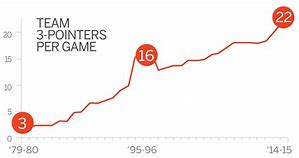Have you noticed that basketball (at all levels) has morphed into a game where players are either going all the way to the hoop to score or settling for a three point shot?
I played basketball until my mid-30’s (not professionally, of course) and participated in the game prior to and after the advent of the three point shot.
Being a tad under 6′ tall myself, my lack of penetrating dribbling skills and size made shooting the basketball from the outside my personal paradise. I was the guy who the coach would shout, “No, no…good shot!” when taking (for me) a relatively comfortable 20 footer from the outside during the two point era.
In those pre-3 days, the statistical evidence was on the side of my coaches. Shots attempted closer to the hoop have a statistically higher percentage of success for most players.
As a result, the game of basketball into the 1960’s and most of the 70’s was dominated by the big men. Talented giants like Wilt Chamberlain, Bill Russell, Kareem Abdul-Jabbar, and Moses Malone were the marquee players of my day. Since teams would generally try to force the ball into the basket for shots, the big men had the double advantage in both getting their own shots off and in grabbing missed shots for rebounds.
Then, the ABA happened. In 1967, The American Basketball Association not only brought us the red, white, and blue basketball, it introduced the novelty called the three point shot. The long-distance shot (which has meandered between 20 to 23 feet over the years) served to loosen-up defenses under the basket while allowing shorter players to showcase their sharpshooting skills from long distance.
Louie Dampier (all 6′ of him) obliterated the ABA with 794 made three pointers to lead the league in long-distance shooting over his career with that league. I was a big fan of Louie’s long distance shooting skills with that red, white, and blue ball. The ABA, for me, became quite fun to watch.
In 1976, the National Basketball Association gobbled-up the profitable ABA franchises (today’s San Antonio Spurs, Indiana Pacers, Denver Nuggets, and Brooklyn Nets) and reluctantly incorporated the 3-point shot into its game.
At the time, the NBA was struggling with a number of serious problems (primarily drugs) and had sunk so low in the public eye that even key playoff games were relegated to late-night replays (after the local news) by CBS due to flagging viewership and fan interest.
The three point shot wasn’t exactly a rousing success in its NBA debut seasons. As the graph at the top of the page shows, teams averaged a paltry three made 3-point baskets per game.
But then the NCAA added a three point shooting line to the college game. High schools and pretty much everyone else quickly followed suit.
Younger players began to practice shooting the longer shots more as the rewards became more apparent. And now, the coaches and players better understand the math involved with this evolution in the game.
If you can make 33% of your attempts at a 3-point basket, your team will score the same number of points as it does making 50% (an exceptionally high percentage) of its 2-point shot attempts. However, if your team can convert three point shots at greater than a 33% clip, you will score more points than the team which doesn’t attempt any threes but shoots 50% from the field on 2-pointers.
It’s all about the math.
Over the past several years, we have seen the art of three point shooting evolve rapidly. Teams such as the Houston Rockets (owners of the best record in the NBA this season) are taking record number of three point attempts this season.
Houston attempts a whopping 42 three point field goals per game (connecting on 36% of them). Last year’s NBA champion, Golden State, is hitting over 39% on its 3’s this season.
The NBA will end-up with 19 of its 30 teams shooting the most three point attempts in their franchise history. Over 25,000 three pointers will be made in the NBA during the 2017-2018 season.
This year’s NCAA men’s division champions, Villanova, rode a wave of three point baskets as it obliterated foes during college basketball’s March Madness.
Is it worth it?
Apparently, yes.
But is basketball quickly becoming more boring to watch as teams eschew an open 15 foot jumper (for 2 points) in lieu of passing the ball to another player to attempt yet another long distance three pointer?
I think it is. Let’s explore some ideas on how to bring back the two point shot in my next post.

